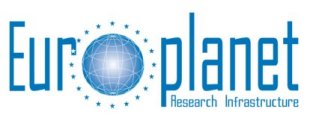The Dust Accelerator FacilityProvided by: Max Planck Institute Nuclear Physics - Heidelberg Homepage: |
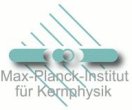 |
Scientific Contact:Dr. R. Srama |
Local administrative contact (once a TNA visit is awarded):Ludmila HollmachMax-Planck-Institut für Kernphysik, Saupfercheckweg 1, 69117 Heidelberg Email: Phone: +49 6221-516 355, Fax: +49 6221-516 220 |
Facility Description
|
The Dust Accelerator is a worldwide unique facility which allows the investigation of hypervelocity dust impacts onto various materials. The facility is designed to study the interaction of micro-grain impacts with target materials like planetary analogues, metals or interplanetary dust collector materials. The accelerator provides a laboratory platform for the study the physics of interplanetary dust impacts and the design and calibration of dust sensor instrumentation for space based applications. Dust grain materials from nano to micron sizes are accelerated, using a 2 MV Van-de-Graaff accelerator, to velocities between 1 and 60 km/s. These velocities are relevant to the study the dust properties in planetary rings of the giant planets and impact ejecta processes on the surfaces of small bodies (asteroids, comets) as well as moons and planetary surfaces. The accelerated micro-grains pass focussing and steering electrodes and their individual speed and charge is measured by sensitive beam detectors working with charge induction. A special control hard- and software, the Particle Selection Unit, determines the grain speed and mass and selects individual dust grains on the basis of a speed and mass window given by the experimentator. The accelerator can be operated in a single-shot mode and in a continuous mode. Dust materials include metal powders like iron or coated microspheres like glass, organic microspheres (polystyrene) or even minerals (pyroxen, anorthite). | ||
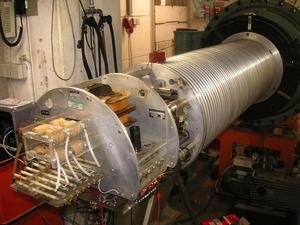 Dust accelerator of MV at MPI Nuclear Physics |
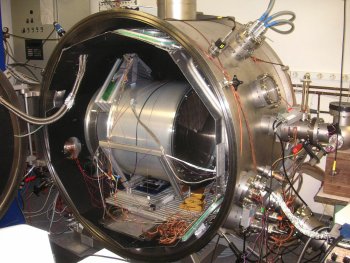 Big experiment chamber (diameter 1.4 m) at the dust accelerator. |
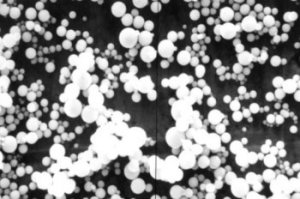 Metal dust power used at the accelerator (0.1 - 2 micron) |
Facility Applications
| Studies at the dust accelerator are multi-disciplinary and are relevant in the field of geoscience, physics, chemistry, astrophysics and astrobiology. Phenomena under study include dust charging, dust magnetosphere interactions, dust impact flashes and the possibility of obtaining compositional measurements of impact plasma plumes. Such data has been shown to be of direct relevance to space missions like Galileo, Ulysses, Cassini, Rosetta, Stardust, New Horizon or BepiColombo. Future projects to the Moon, to the inner Solar System (Solar Probe Plus), to the Jovian system and to Saturn will carry dust instrumentation which has to be developed with the help of micrometeoroid impact simulations in the laboratory. The recent Stardust mission collected and returned samples of interplanetary and interstellar dust grains to Earth. Sample preparation and analysis requires the study and understanding of grain-collector material interaction during hypervelocity impacts. Test and calibration of dust collectors and of in-situ dust detectors onboard interplanetary probes or Earth satellites is a major application of the facility. The laboratory generation and analysis of in-situ mass spectra of high-speed organic micro-grain impacts is essential for astrobiology studies and provide the basis for an understanding of the composition of interplanetary or interstellar micrometeoroids. |
Facility References
Selected relevant publications
Low charge detector for the monitoring of hyper-velocity micron-sized dust particles
Srama, R., Auer, S., Meas. Sci. Technol. 19 (2008) 055203, doi:10.1088/0957-0233/19/5/055203
Acceleration of dust particles
S. Auer, In "Interplanetary Dust", Ed. E. Grün, B. A. S. Gustafson, S. F. Dermott, H. Fechtig, Springer, 2001, p431-433
Laboratory simulation improvements for hypervelocity micrometeorite impacts with a new dust particle source
M. Stübig et al., Planet. Space. Sci. 49/8, p853-858, 2001.
Electrostatic acceleration of microparticles to hypervelocities
Shelton, H., Hendricks, Jr., C. D., and Wuerker, R. F., J. Appl. Phys. 31, 1960, p1243-1246
Micrometeoroid simulation using nuclear accelerator techniques
Friichtenicht, J., F., Nucl. Instrum. Meth., 28, 1964, p70-78
Charging and acceleration of microparticles
Vedder, J. F., Rev. Sci. Instruments, 34, 1963, p1175-1183
For information on the Europlanet TNA programme contact:
Professor N J Mason, Department of Physics and Astronomy, The Open University, Walton Hall. Milton Keynes, MK7 6AA
Email (preferred method of contact)
